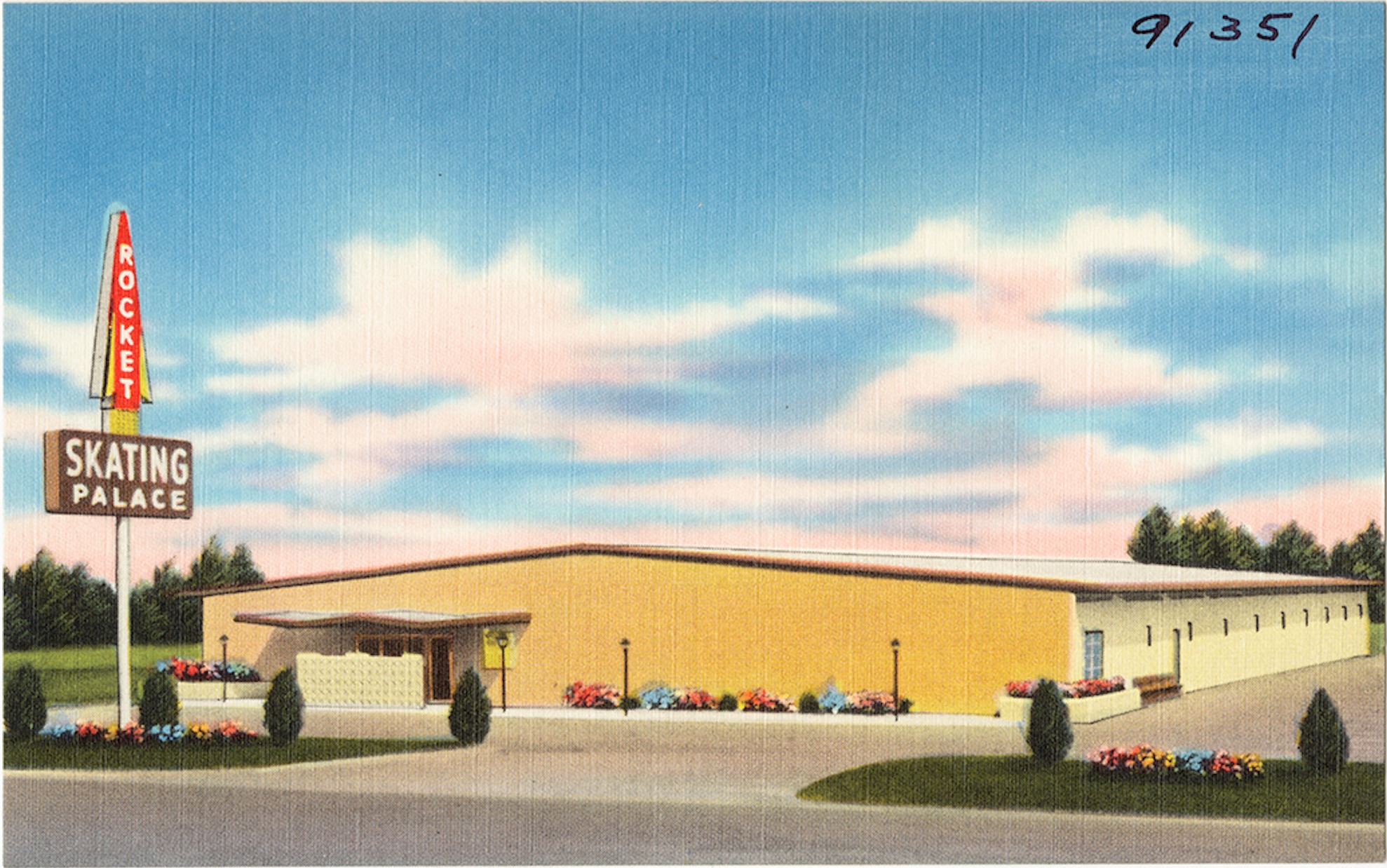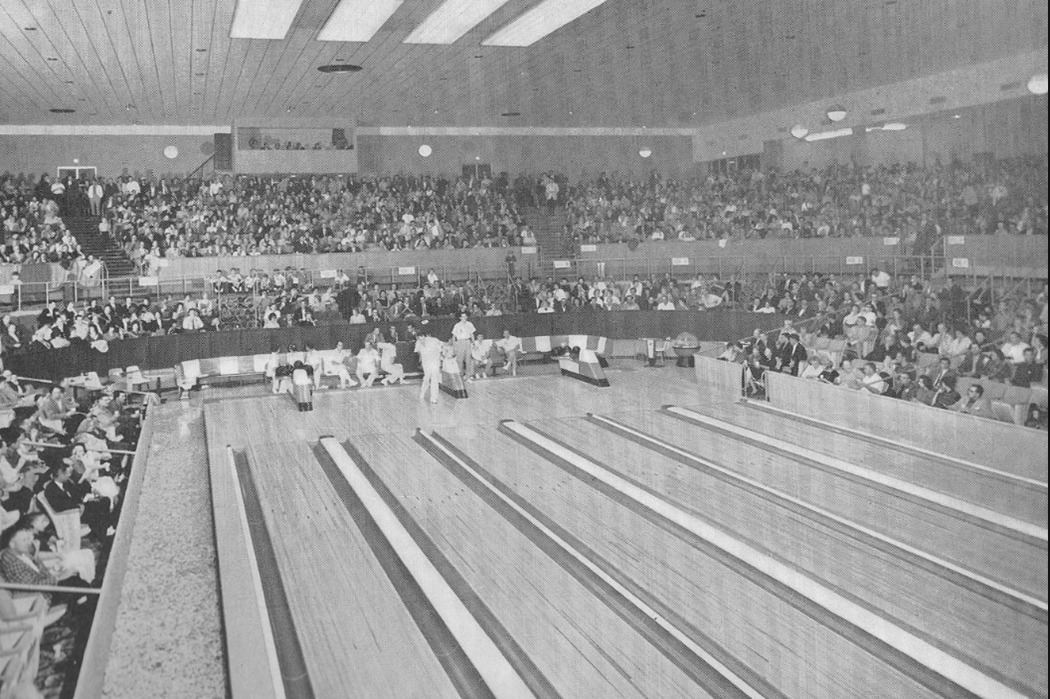Saturday nights in Oak Cliff nowadays could include live music at the Kessler, art-house films at the Texas Theatre, art-gallery openings, local craft brew and fine dining.
Forty years ago, things were a little less high class. On a Saturday night, Oak Cliffers enjoyed the simple life while still getting their kicks.
Our neighborhood was dry from 1956-2011 — you had to “go across” to buy alcohol on the other side of the Trinity River or in the Tarrant County part of Grand Prairie. By the 1970s, the swanky nightclubs and dancehalls of El Tivoli were long gone.
But locals found ways to hang out in Oak Cliff without “going across.”
Here are three ways to let loose in 1970s Oak Cliff.

A vintage post card depicting Rocket Skating Palace on Cockrell Hill Road. The Rocket was an Oak Cliff hangout for decades. Image courtesy of the Boston Public Library.
Rocket Skating Palace
Jack R. Barbre and Walter D. Young opened this roller rink on Cockrell Hill Road in the 1950s.
Early on, it was a place to glide across the floor to Jo Stafford singing “You Belong to Me.” In those days, the roller rink was about couples skate-dancing.
But it wasn’t long before the British Invasion hit, along with Oak Cliff’s garage-rock scene. The skating palace hosted sock hops and live performances from popular Oak Cliff bands including Kempy and the Guardians through the 1960s.
By the ’70s, it was a hangout for local kids who liked KISS and Aerosmith.
Neighborhood resident Jo Simpson told the newspaper in 1974 that she’d recently visited Rocket Skating Palace on a Saturday night, “and found to her horror that people were actually skating to rock music.”
“They ought not to put rock music in skating rinks,” she told the paper. “If that’s what it’s all come to, they should just shut them down.”
The scandal!
The same story reported that some people showed up in skating costumes, and others were in blue jeans.
The Rocket held contests — limbo, racing and couples skate.
Gary Edwards, who was 34 at the time, frequented the skating palace with his girlfriend Mary Dalton. On this one night in 1974, she was wearing a velvet skating costume, and they had worked out a routine for the couples-skate competition.
“We dress up and come here the way some people dress up and go to a club somewhere,” she told the newspaper.
The Rocket Skating Palace is still there, although it hasn’t been used as a roller rink in a long time. Wrestlers started putting on shows there in the 1990s, and matches were held there as recently as a couple of years ago. The iconic rocket sign was mentioned in an AIA Dallas article about “witty” signage that’s worth preserving in Dallas.

The Bronco Bowl’s pro bowling arena in 1961. Professional bowling at the Bronco Bowl was short-lived, but the enormous complex was a mainstay of Oak Cliff entertainment until 2003. Photo courtesy of the International Bowling Museum & Hall of Fame.
Bronco Bowl
The 78-lane Bronco Bowl was built in 1961 for $3 million on the prospect that a televised professional bowling league, the NBL, would take off.
That league folded the following year, but the Bronco Bowl remained as an Oak Cliff hotspot for decades.
It’s most often remembered as a legendary live-music venue. David Bowie, The Clash, Public Enemy, Pantera, U2, Metallica and Bruce Springsteen all headlined there in the 1990s.
But in the ’70s, it was a divey hangout for straight-laced dads to roll off some steam.
Since Oak Cliff was dry, the Bronco Bowl was BYOB.
Dan Bullard of Oak Cliff carried his beer in a Styrofoam ice chest. He said he liked seeing the jumbo American flag above the lanes, and he wasn’t fond of the longhair types.
“My wife and I have gone bowling in Oak Cliff every Saturday night since we were married, and we’re about to celebrate our 15th wedding anniversary,” he told the newspaper in 1974. “And I can tell you one thing. You won’t find anyone here tonight with hair any longer than they wore it the night of our wedding reception. It’s nice to know that some things never change.”
The Bronco Bowl was torn down in 2003 to make way for Home Depot.
Bingo halls
Rose Green, a widow in her 50s, played bingo four nights a week in Oak Cliff in the mid-1970s, all at different halls and veterans clubs. The Bronco Bowl had bingo too.
On Saturday nights, Green put her hair in big rollers to have it nice for church on Sunday, tied a red scarf around her head for luck and posted up at the bingo hall with her friends.
She told the newspaper in 1974 that cards cost about $3 apiece, and you could win up to $1,000 cash. People came from all over the city to play bingo in Oak Cliff, and the bingo halls usually were BYOB.
For-profit bingo was illegal, and a 1975 court ruling found that charity fundraising via bingo was just as illegal (the Texas Legislature made bingo-for-charity legal in 1981).
Thus the Dallas Police Department started raiding Oak Cliff bingo halls in the mid-1970s. They told the newspaper in 1975 that they typically only shut down games when there was a complaint.
“We just don’t have the manpower to go out and check lodges to see if they’re playing bingo,” Lt. Richard P. Horn of the DPD vice unit told the newspaper.
Green had been witness to a bingo raid and was slightly disappointed that it wasn’t more exciting.
“I thought we’d get arrested like in the movies,” she told the newspaper. “I wondered what my son was going to say. But nothing happened to us, just the people who run the bingo.”
Police raided the Amvets Post on Dawes Drive (it’s no longer there), where there were several bingo games a week. Police cracked down on them because their games were “big, flagrant and had been advertised,” the police said.
After that, the Amvets canceled their annual Christmas party for veterans in Waco. And the police began receiving calls from “little old ladies in Oak Cliff” who were livid about losing their bingo game.





